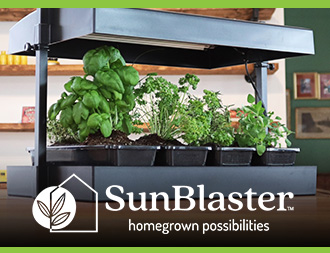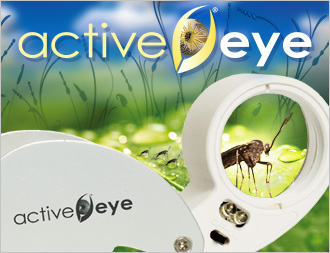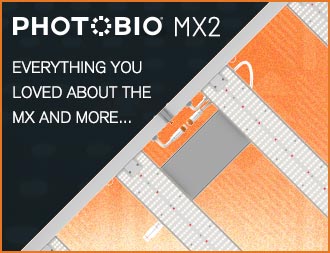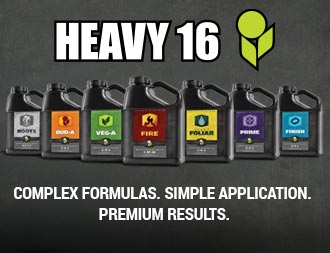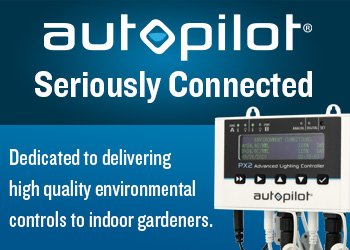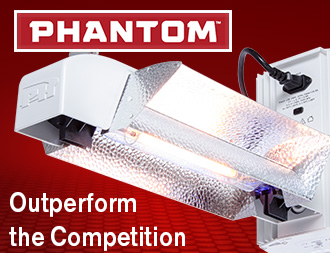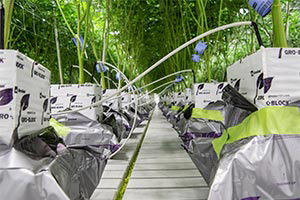Introduction
A substrate growing system is a hydroponic system where the root zone is physically supported by media. The plants are fed by applying nutrient solution to the media. This system is in contrast to an NFT (nutrient film technique) type hydroponic system where the root system is not supported by a growing media but is bathed directly in the nutrient solution.
Almost any material that supports the root system, other than soil, is considered a substrate. Substrates can be organic such as peat, pine bark, sawdust, rice hulls etc.. They can be petroleum based such as polymeric foams or plastic beads or they can be inorganic mineral based as are sand, gravel, perlite and rockwool. There are a number of reasons for using substrates to support the plant root system in a hydroponic growing system. In addition, an effective substrate should possess certain qualities. In this presentation I will elaborate on the properties and use of rockwool as a substrate for hydroponic growing systems. While doing this I will develop some of the advantages there are to using substrates and contrast the differences between substrates.
What is Rockwool?
Rockwool is a man-made mineral fiber. The vast majority of rockwool used in the world is used for insulation purposes much like fiberglass. However, the properties of rockwool can be substantially changed by adjusting the mineral content. In the early 1960s it was found that following several modifications to the manufacturing process rockwool would support and, under the right handling practices, promote plant growth. This specially produced horticultural rockwool is what is primarily sold as a hydroponic substrate. (From now on the term "rockwool" will specifically refer to the horticultural grade product).
Rockwool is manufactured by melting basaltic rock and spinning the melt into fibers. Immediately following spinning, a binder is added to the fibers and they are compressed and cured into large slabs. By adjusting the amount of pressure, the density of the media is adjusted. The large slabs can be cut into smaller slabs and propagation blocks for easy handling. The spun fibers are also formed into a granulated (flocked) product which can be handled in a manner similar to bales of peat.
All rockwools are not the same. The best are produced from pure basaltic rock (diabase). The rockwools produced from diabase have a mineral balance that is inert and nonreactive. A few rockwools are produced from slag left over from smelting operations. These rockwools contain a high proportion of metals and may be somewhat reactive with the nutrient solution. High quality rockwools should have a uniform fiber diameter, even binder distribution and a low proportion of shot (mineral pellets that have not been spun into fibers). The most important quality a high grade rockwool should have is uniform wetting. The rockwool should wet easily but not remain water-soaked. Good drainage is important.
The wetting characteristics of rockwools vary considerably. Rockwool fibers are naturally hydrophobic (they repel water) because of the presence of mineral oil. In the highest quality rockwools the mineral oils are removed during the manufacturing process and mineral wetting agents are incorporated in the melt. This form of horticultural grade rockwool naturally attracts water and wets easily. While this is the highest quality process the actual quality of the rockwool will depend upon the care taken in manufacturing. Other manufacturers simply add or provide a chemical surfactant (essentially a refined soap) that allows the naturally hydrophobic rockwool to hold water. The major drawback to this approach is that the wetting agent must be supplied regularly or it may wash out.
The best way to determine the quality of the various rockwools available is to test them. See if the wetting is uniform or if there is a large proportion of shot. If you want to try a new product it is worth the time to test it.
Why use a Substrate in your Hydroponic System?
The answer to this question depends a lot on the crop that is being grown. Substrates have been successfully employed in the cultivation of most vegetable vine crops grown in the greenhouse such as tomatoes, cucumbers and peppers and some cut flowers such as roses and gerberas. Let us consider the advantages for using substrates with these crops.
The primary reason for using rockwool, or any substrate, in a hydroponic growing system is to provide a buffering reservoir of nutrient solution in the root zone while maintaining an adequate volume of air (oxygen) in contact with the roots. In an NFT or other "pure" hydroponic system, the watering and feeding of the plants depends solely upon the flow of nutrient solution past the roots. If this is interrupted, for even. a short time, the plant will die. On the contrary, if the root zone is flooded the roots will suffer for lack of oxygen. In a substrate system, the substrate maintains a reservoir of nutrient solution in the root zone along with a percentage of air pore space. This reservoir of nutrient solution is available even when the irrigation syst em is off for periods of time. In fact, in a substrate system irrigations are pulsed to help maintain the proper ration of air to water.
The reservoir of nutrient solution that the substrate provides also increases the time it takes to change conditions in the root zone. Thus, the grower looses some of the immediate control over conditions in the root zone that an NFT type system would offer. The key is to use a substrate that offers the safety provided by a reservoir of nutrients, water and air that also will respond rapidly to changes in the feed made by the grower. For example, in a rockwool system changes made by the grower are fully manifested in the root zone in 12 to 24 hours. This varies from substrate to substrate and will be discussed later.
Properties of Rockwool as a Substrate
The water holding capacity and drainage characteristics of substrates vary. Grodan rockwool, when allowed to drain by gravitational pull, i.e. at field capacity contains 80% solution, 15% air pore space and 5% rockwool fibers. This ratio of solution to air promotes vigorous root growth. Plants growing on rockwool will remove solution and increase the ration of air-pore space to solution. Thus, if a higher proportion of air is desired in the root zone increasing the time between watering will increase the percent of air.
The tension required to remove solution from rockwool increases only slightly as rockwool dries. This means that it is as easy for a plant to remove solution from saturated rockwool as it is from rockwool that has given up 50% or even 70% of its moisture. Thus, plants grown in rockwool are not exposed to water stress until the rockwool is almost completely dry. Given that a standard rockwool slab used for tomato production holds 15 liters of water, the grower has tremendous flexibility with regard to watering and control over the air content of the root zone. However, the grower must be careful because the plants will not show signs of water stress until it is too late. A watchful eye on the conditions in the root zone is required.
Substrate Irrigation
Rockwool can be used in either a recirculating irrigation system or in a "drain to waste" (single pass) system. In the former, the runoff the nutrient solution is collected, replenished and reapplied to the substrate. In the single pass system the runoff is drained into the ground or routed to a holding pond. The most common substrate irrigation system is the single pass system. The main reason for this is that the grower always knows the composition of the nutrient solution he is applying. In a recirculating system the solution will gradually become unbalanced, unless the solution is tested for each nutrient. A rapidly growing vine crop such as tomato can remove a considerable amount of nutrients in a day. In a "drain to waste" system the grower can increase the feeding time and be confident a balanced solution is reaching his crop.
A second reason for using a "drain to waste" system is to avoid the spread of disease. In most substrate systems only a few plants share the same root zone and any disease will be confined to these few plants. The argument is that disease can spread throughout a recirculating system. However, the evidence that disease will spread through otherwise healthy plants is unconvincing. Usually the plants must be stressed or damaged before disease will spread. Thus, the management of the nutrition in the root zone rather than disease control is a far more important argument for using a single pass irrigation system.
The main drawback of a single pass system is that fertilizer is wasted. In general, about 15% to 20% of the nutrient solution applied is runoff. This is not a large amount given the control over nutrition that is possible. As technology becomes available that allows for the testing and replenishment of individual nutrients, a recirculating system that provides a balanced feed, without the waste, will be possible. For now this technology is too complicated and expensive.
Control over Nutrition In a Substrate System
The practical way to reduce salt concentration in a substrate is to increase the amount of solution that leaches out of the substrate. As a plant transpires, it removes water and leaves behind salts. Applying excess fertilizer solution each time the plants are watered ensures that these salts are washed out. If the electrical conductivity (EC) in the substrate is high, you may want to leach up to 50% of the volume you add each time you irrigate. If the EC in the substrate is close to what you are feeding, then yot may want to leach less.
As a rule of thumb, irrigation should be short and frequent in order to maintain the solution level in the substrate at "field capacity". For Grodan rockwool, this may be up to 20 times per day. The number of irrigations per day is dependent upon the envi ronment the plant is exposed to. On a hot, sunny day or on a day where the relative humidity is low, the plant will require a high number of irrigations. Under cloudy or high humidity conditions, conditions where the plant is not transpiring at a great ra te, the number of irrigations may be as low as 5 or even once a day.
The duration of each irrigation will determine how much leachate, and therefore the EC in the slab. Under normal conditions, the EC in the slab should be 0.2 to 0.5 mmhos/cm higher than that which is applied to the slab. Leaching 20% each irrigation will usually result in the proper level of fertilizer in the substrate, but again, this depends on how much the plants are transpiring. The amount of leachate is increased to decrease the EC in the slab, while a small amount of leachate will usually result in higher EC's in the slab. Proper control of water and fertilizer availability is critical to maximizing yield.
Set-up of a Rockwool System
In many ways the setup of a rockwool or substrate growing system for vine crops is simple and inexpensive. The irrigation/feed system itself is a simple drip irrigation system with dripper capacity of 2 litres/hour and one dripper for each plant. The nutr ients are supplied using a two-head injector and fertilizer concentrate tanks. By knowing the bicarbonate concentration of your raw water, the appropriate amount of acid can be added to your concentrate tanks so that the pH of your feed solution is between 5.5 and 6.0. Remember that it is important to have your raw water analyzed so that a properly balanced nutrient formula can be mixed.
Timing of irrigation can be accomplished by simply attaching a timer to a solenoid value in the feed line. Irrigation controllers are also available. For rockwool growing it is possible to use an irrigation control tray. This tray indirectly measures the water content of the rockwool slab and triggers and irrigation when the level drops below a set amount. This system automatically provides water based on plant demand giving the grower more time to spend managing the crop.
The exact layout of the greenhouse depends upon the crop grown. Generally, the floor is covered with white or preferably black and white poly. Rockwool slabs are placed in the rows, holes for plants are cut in the plastic surrounding the slabs and the drippers placed in the holes. The irrigation system is turned on and the slabs fill with solution. Seedlings are placed on the slabs and drainage slits cut in the slabs as well as the plastic floor.
The key factor in managing the system is measuring the pH and EC in the slab. Samples should be taken in the morning, more often if possible. Even though the substrate has a considerable buffering capacity, the EC and pH may change during the day. The concentration of salts in slab are managed as previously discussed. Eventually the grower acquires a feel for how much solution the crop uses in a day and how the pH and EC change. He can then adjust the frequency and time of irrigation in anticipation of these changes.
Rockwool and other Substrates
Rockwool is an inorganic substrate as are sand, gravel and perlite. The main features of this class of substrates are that they have little cation exchange capacity and they maintain their structure over a long period of time. In general, at field capacity, rockwool holds more water per unit volume than the other inorganic substrates and therefore has a greater buffering capacity. The larger reserves of a nutrient solution coupled with excellent drainage makes rockwool easier to handle as an inorganic sub strate.
Organic substrates, peat, sawdust, etc. can have excellent water holding and release characteristics. The major drawback of these materials is that they decompose over a period of time. As decomposition proceeds the water holding capacity of the substrate changes. Thus, the grower must be aware of not only the growth of the plant but the changes in the substrate. For growers who are not experienced with hydroponics or liquid feeding the organic substrates may be easier to learn on than the inorganic substrates. Organic substrates, especially peat, have some cation exchange capacity. This gives the grower some buffer against nutrient changes in the root zone. This may help the new grower manage nutrition. Another advantage of most organic media is that they are inexpensive. Of course the grower must always balance the cost with the effectiveness and yield.
The hydrocarbon-based substrates have not been widely used. The water holding capacity of these can be very good. Their longevity is generally better than the organic substrates, but is not as great as inorganic substrates. The lack of wide acceptance of these media may have to do with cost.
Conclusion
The use of the hydroponic substrate system in general and rockwool in particular for vine crop and some cut flower production has been proven worldwide. In Holland, a respected world leader in greenhouse vegetable and cut flower production, of 3550 hectares of vegetables, 2350 are on substrate and 1980 of that are on Grodan Rockwool. Considering cut flowers, of the 1600 hectares total, 160 hectares are on Grodan Rockwool. In North America the trend is toward growing on substrates. Ease of handling (labor savings), better control over nutrition and better disease management are all reasons for this trend. These factors all point to more yield at lower cost.
Michael F. Dowgert studied agriculture at the University of Massachusetts where he received his B.S. and at Cornell University where he received his Ph.D. He worked in production and research at GLIE Farms in New York where he was responsible for greenhouse and field production of culinary herbs. He also conducted research on preservation of herbs. He is currently responsible for research projects and coordination of information on greenhouse production techniques at Agro Dynamics.
Courtesy of the Hydroponic Society of America. Used by permission.


